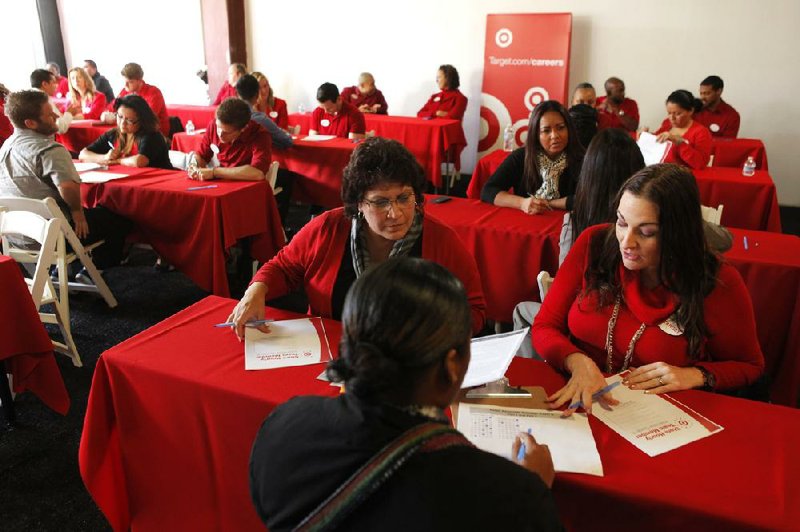WASHINGTON — Job openings dropped in December from a more than four year high, a sign that further progress in the labor market will be slow to develop, analysts said.
The number of positions waiting to be filled fell by 173,000 to 3.62 million, the fewest since September, from a revised 3.79 million the prior month that was the most since May 2008, the Labor Department said Tuesday. Hiring and firing also cooled.
More work opportunities would help reduce an unemployment rate that’s been either 7.8 percent or 7.9 percent since September, and hearten Federal Reserve policymakers who say unemployment is too high. A Labor Department report earlier this month showed employers took on 157,000 workers in January, the fewest in four months.
“We can’t seem to generate any positive momentum in the labor market for more than a quarter,” said Omair Sharif, a U.S. economist at RBS Securities Inc. in Stamford, Conn. “Domestic demand is still growing at a slow pace, and that’s keeping job growth in check, and all the crises, whether they’re in Europe or homemade, are keeping a tight lid on our ability to maintain any momentum.”
Tuesday’s report illuminates the dynamics underlying the government’s monthly employment figures. Payrolls increased by a revised 196,000 workers in December and 247,000 the month before, the Labor Department said Feb. 1. Revisions added a total of 127,000 jobs to the count in the last two months of 2012.
The number of workers hired in December dropped to 4.19 million from 4.4 million, pushing the hiring rate down to 3.1 percent from 3.3 percent, according to Tuesday’s report.
Six of seven major industry categories showed a drop in job openings in December, led by professional and business services, which had a 92,000 decrease in jobs available. Trade and transportation followed as retailers sought less help.
Construction was the only category to show an increase, with job openings rising by 3,000 to 92,000.
Total separations, which include firings and those who leave their jobs voluntarily, decreased to 4.07 million in December from 4.22 million. That drove the separations rate down to 3 percent from 3.2 percent in November.
Of those, 2.16 million people quit their jobs in December, down from 2.18 million in the prior month.
In the 12 months ended in December, the economy created a net 1.8 million jobs, representing 51.8 million hires and about 50 million separations, Tuesday’s report showed.
Home Depot Inc., the largest U.S. home-improvement retailer, is among companies stepping up hiring. The largest U.S.
home-improvement retailer, said it plans to add more than 80,000 temporary workers ahead of its busiest season, about 14 percent more than a year ago, as a housing rebound spurs spending on remodeling and landscaping. Rival Lowe’s Cos. is increasing its seasonal hiring by 13 percent.
Considering the 12.2 million Americans who were unemployed in December, the figures indicate there were about 3.4 people vying for every opening, up from about 1.8 when the recession began in December 2007.
Job generation in 2012 was strong enough to bring the U.S. unemployment rate down 0.7 of a percentage point to a four year low of 7.8 percent in December. Employment picked up in the last three months of the year, when payrolls expanded by 603,000 workers.
A possible slowdown in consumer spending and government cutbacks threaten to impede further progress in the labor market. Payroll growth in January was the weakest in four months, and households this year will see their paychecks reduced by higher payroll taxes while Congress debates whether to slow the growth of federal outlays.
Fed officials are waiting until the outlook improves before they tighten monetary policy. The central bank’s Federal Open Market Committee said in December it would hold its benchmark lending rate near zero as long as inflation isn’t forecast to rise more than 2.5 percent in one to two years and unemployment remains above 6.5 percent.
“With employment so far from its maximum level and with inflation currently running, and expected to continue to run, at or below the Committee’s 2 percent longer-term objective, it is entirely appropriate for progress in attaining maximum employment to take center stage in determining the committee’s policy stance,” Fed Vice Chairman Janet Yellen said Monday during a speech in Washington.
Yellen also said she believes high unemployment is the result of too little demand rather than a mismatch of workers’ skills with the needs of employers. The economy faces hurdles including low income expectations by households and fiscal restraint, she said.
Information for this article was contributed by Chris Middleton of Bloomberg News.
Business, Pages 29 on 02/13/2013
